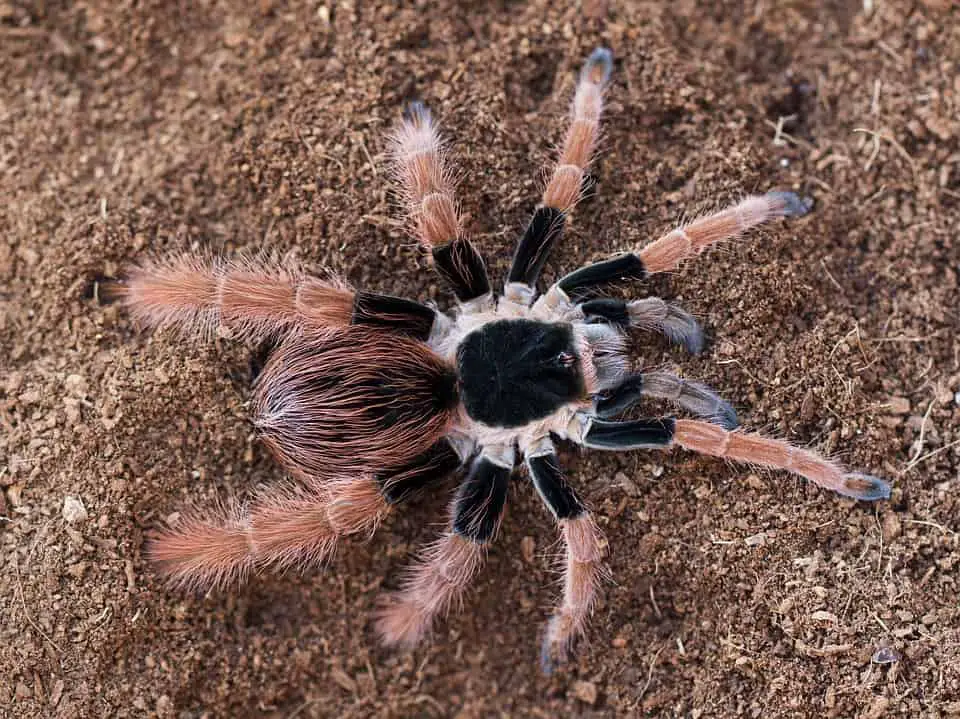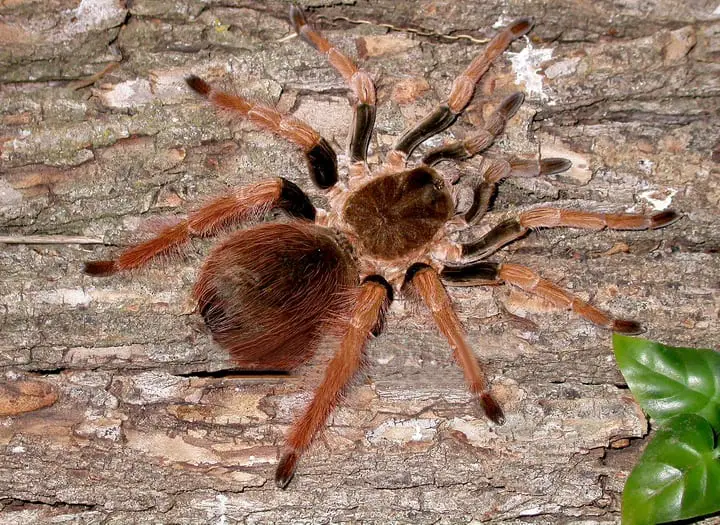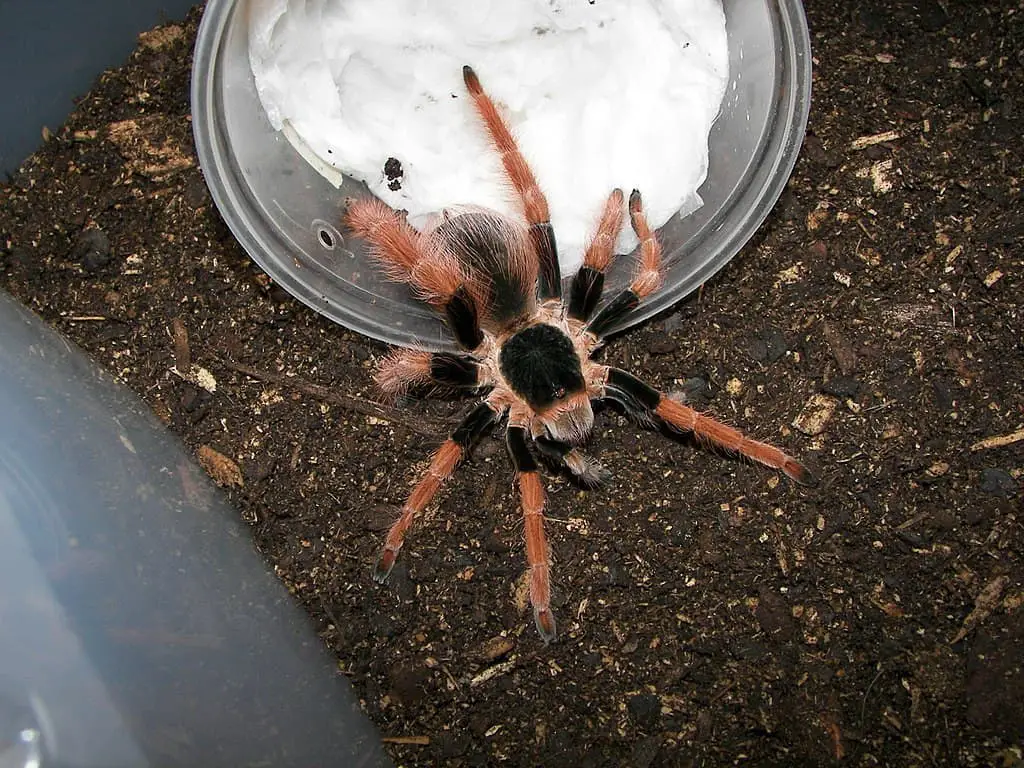The Colombian Giant Redleg Tarantula (Megaphobema robustum) is a New World terrestrial species. She’s native to the lowland region of Colombia, particularly in “Los Llanos.”
Known for being one of the most enormous Tarantulas, the Colombian Giant Redleg can grow to a stunning size of eight inches, a size that really serves to bring out her beautiful coloration.
However, in spite of her vast size, this tarantula is pretty calm overall, being only skittish sometimes when she feels threatened. They’re gentle giants that are well suited for beginners.
If you’re interested in getting one of these tarantulas, here’s everything you need to know about the gigantic beauty.

Colombian Giant Redleg Tarantula Care Sheet
| Species Name | Megaphobema robustum |
| Family Name | Theraphosidae |
| Common Names | Colombian Giant Redleg Tarantula |
| Category | New World |
| Type | Terrestrial |
| Native Location | Colombia |
| Body length | 2 to 3 inches (5-7 cm) |
| Leg Span | 6 to 8 inches (15-20cm) |
| Growth Speed | Medium/fast |
| Urticating Hairs | Yes |
| Social | Solitary |
| Diet | Insects: primarily crickets and roaches |
| Temperature | 70 to 80 degrees °F |
| Humidity | 60 to 70% |
| Lifespan | Female: 16 to 20 years / Male: 3 to 5 years |
| Experience required | Beginner |
| Minimum tank size | 18″Lx18″Wx12″H |
Colombian Giant Redleg Tarantula Overview
The Megaphobema robustum, commonly named The Colombian Giant Redleg Tarantula, is a Terrestrial Opportunist Burrower that tends to stay hidden inside her burrow.
Even so, she’s described as relentless when she gets the chance to eat, accepting food at almost any time, which is something you should have in mind when you’re thinking about adding her to your collection.
As a New World Species, she can throw urticating hair when frightened or threatened, so she should be handled carefully.
She exhibits variable colors ranging from light brown to red, with darker tones spread throughout her body. The Colombian Giant Redleg also has a peculiar threat stance, different from that of her cousins in the same sub-family.
Due to her accessible price and calm behavior, it’s very well suited for beginners looking for an exotic pet.
Appearance & Variants
The Colombian Giant Redleg Tarantula displays a light brown color on her legs, cephalothorax, and abdomen, with slight hues of red and cream tones in her hair that are sometimes orange instead of brown.
Her femurs and cephalothorax often have darker coloration, creating an incredible pattern. Her legs are barbed, so you can see a few tones overlapping as she moves, giving her an intimidating look that’s cool to see.
Males and females are very similar, both displaying the same striking colors. The only difference between them is their sizes since males are slightly smaller than females; therefore, the only reliable way to sex these tarantulas is by looking at the inside of their molts.
They’re a very large species, growing to a maximum size of about 8 inches.
Price
The Colombian Giant Redleg Tarantula’s price varies on the sex and maturity state of the specimen.
An unsexed or adult male can be bought for $75 to $110, meanwhile, females can be purchased for around $160.
Behavior and Temperament
It’s been reported by owners that the Colombian Giant Redleg Tarantula has a strange tendency to roam around her enclosure, grab things to relocate somewhere else, and then move on with her life.
Not sure if she’s a perfectionist or just a goofball that likes to mess things around, make sure to give her plenty of foliage and other decorations to keep her busy.
As she enters into a more mature state, she’ll start to spend more time in her burrow. Her senses are a bit dull for a terrestrial burrower, so be alert to her activity as she goes deep into her burrow.
Sometimes she won’t be able to detect her prey and go without eating for a while before going out herself, so make sure to keep an eye on her and draw her out to feed if she’s too lazy to go up by herself.
Described as serene most of the time, the Colombian Giant Redleg Tarantula can get skittish quickly if she feels frightened; in such cases, she will run straight to her burrow and hide.
Reports where keepers had to deal with her threat posture and defensive maneuvers happen because of a lack of space or comfort in her enclosure.
Therefore, try to give her as much space as possible and avoid rehousing her unless it’s necessary.
If the threat is prolonged, she’ll resort to her four-barbed legs to restrain her aggressor. By moving up and down and switching angles for better kicking moves, the Colombian Giant Redleg can even confuse the enemy by turning and then propelling her urticating hair at it.
Known as this spider’s particular threat stance, she’ll elevate her abdomen and spin in circles flicking hair in all directions.
Caring for a Colombian Giant Redleg Tarantula

Temperature and Humidity
The Colombian Giant Redleg Tarantula comes from lowland Colombia, in the “Los Llanos” region, close to the border with Venezuela. However, there are no sightings of her in other countries even though they share similar climates.
She lives in a savanna-like ecosystem with high temperatures and rainy seasons throughout the year.
The temperature in her native territory is around 75°F to 82°F degrees, which is an excellent fit for her tank setup, combining it with 70% to 80% humidity.
Substrate
The Colombian Giant Redleg Tarantula is a burrower, so she needs enough substrate to burrow comfortably. However, as mentioned previously, too much substrate may keep these beautiful spiders from feeding, so it’s better not to overdo it.
Spiderlings should have around 1.5 to 2 inches of substrate, while juveniles and adults need at least 4 inches, but not much more.
Coconut fiber, peat moss, and topsoil are a good choice for this species; having a layer of dirt at the top for firmness isn’t a bad idea either.
Tank
The Colombian Giant Redleg Tarantula needs a fossorial setup. For spiderlings, 0.5 gallons is more than enough until they go into more mature stages of their life.
Once she grows into adulthood, she’ll start requiring a lot of space. An 18″ x 18″ x 12″ setup lets her move around freely and is plenty high enough to allow for enough substrate for her to burrow.
As an opportunist burrower that loves hiding and moving things around, you should give her materials to work with. A piece of cork bark to hide and plenty of artificial plants will make the best environment for her.
Watering
Keeping a Colombian Giant Redleg Tarantula hydrated is simple, put a water dish inside the tank and refill it as soon as needed. Spray the substrate once or twice a month to keep the deeper layers moist; this will be enough for her.
Social
The Colombian giant Redleg Tarantula is not a social species and should not be housed communally. They can be quite territorial which will result in cannibalism if they are housed together. To keep them happy and safe, house them in solitary enclosures.
Diet & Feeding
The Colombian Giant Redleg Tarantula Tarantula is known for an appetite that matches her size.
Spiderlings can be fed with flightless fruit flies, mealworms, or small pre-killed crickets twice a week.
Juveniles could have two medium crickets every week.
Adults can be tricky, and how much they should eat depends on their size. Typically three to five large crickets or one or two big roaches are used for feeding depending on the specimen.
They can survive months without eating, so feed them as often as you see necessary. Just follow their abdomen adaptations to ensure you’re not overfeeding or underfeeding them, and you’ll be fine.
Colombian Giant Redleg Tarantula Facts
- It was first described in 1875 by the arachnologist Anton Ausserer.
- This spider is known as one of the biggest tarantulas from the genus Megaphobema, and one of the biggest tarantulas in the world next to the Theraphosa Blondi and the Phrixotrichus vulpinus.
- Their unique threat stance is often effective. They confuse their predators using their colors as they turn around right before resorting to their urticating hair.
Final words
With her large size, low cost, and beautiful appearance, the Colombian Giant Redleg Tarantula is a popular spider, especially among beginners looking to start in the hobby.
However, even if you’ve already got a lot of experience under your belt, these spiders are not to be overlooked and can be a great addition to your collection.
- How Long Do American Eskimo Dogs Live? Important Factors and Care Tips - September 29, 2023
- Do American Bulldogs Need Grooming? Essential Tips and Care Guidelines - September 29, 2023
- Do Bengal Cats Enjoy Playing? Essential Tips for Keeping Them Active - September 29, 2023
